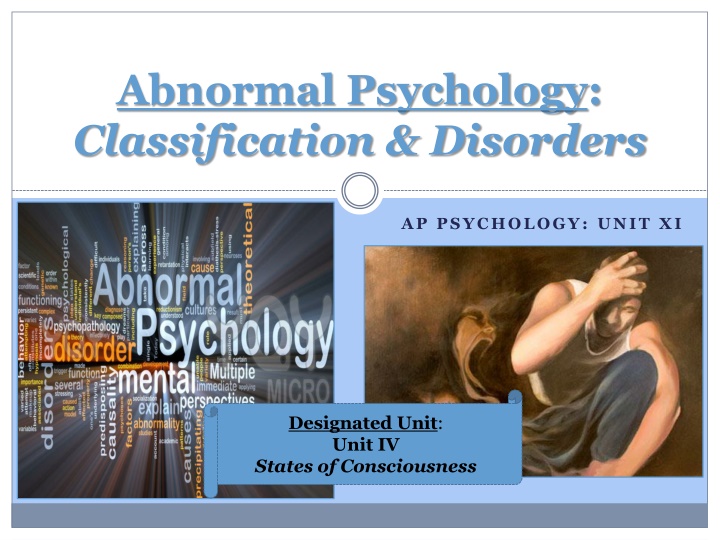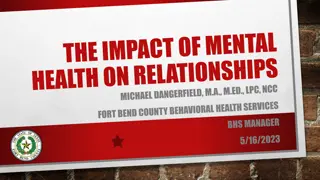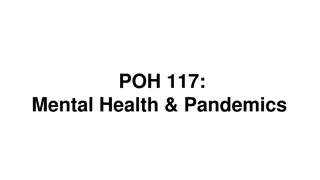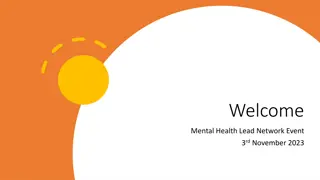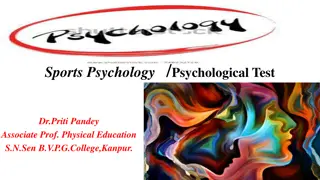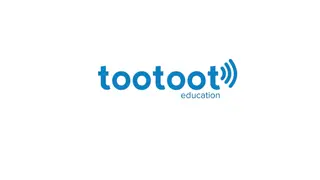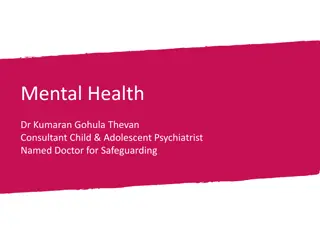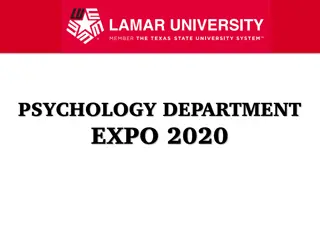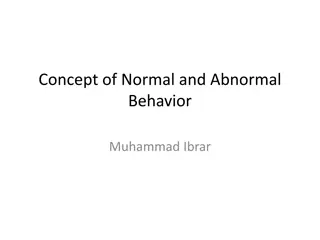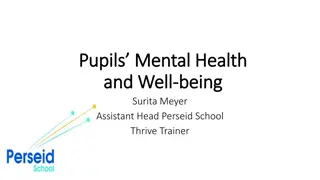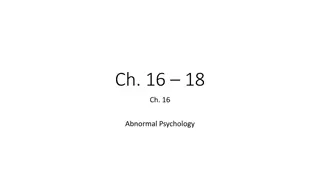Insights into Abnormal Psychology and Mental Health Trends
Delve into the realm of abnormal psychology with a focus on classification, disorders, and prevalent misconceptions. Explore the impact of stigma, genetic predispositions, and societal trends on mental health. Engage in thought-provoking activities to enhance understanding of psychological phenomena.
Download Presentation

Please find below an Image/Link to download the presentation.
The content on the website is provided AS IS for your information and personal use only. It may not be sold, licensed, or shared on other websites without obtaining consent from the author.If you encounter any issues during the download, it is possible that the publisher has removed the file from their server.
You are allowed to download the files provided on this website for personal or commercial use, subject to the condition that they are used lawfully. All files are the property of their respective owners.
The content on the website is provided AS IS for your information and personal use only. It may not be sold, licensed, or shared on other websites without obtaining consent from the author.
E N D
Presentation Transcript
Abnormal Psychology: Classification & Disorders http://www2.sunysuffolk.edu/benharm/abnormal-psychology-background-concept-glowing-6c0c1d.jpg AP PSYCHOLOGY: UNIT XI http://www.mentalhelp.net/images/root/amber_osterhout_painting.jpg Designated Unit: Unit IV States of Consciousness
Introduction: Fact or Falsehood? Research suggests that the stigma & stress associated with being homosexual increase the risk of mental health problems True In America, research indicates that there are more prison inmates with severe mental disorders than there are psychiatric inpatients in all of the country s hospitals True
Introduction: Fact or Falsehood? About 30% of psychologically disordered people are dangerous; that is, they are more likely than other people to commit a crime False Identical twins who have been raised separately may develop the same phobias True Dissociative identity disorder is a type of schizophrenia False
Introduction: Fact or Falsehood? In North America, today s young adults are three times as likely as their grandparents to report having experienced depression True White Americans commit suicide nearly twice as often as black Americans do True There is strong evidence for a genetic predisposition to schizophrenia True
Introduction: Fact or Falsehood? An estimated one in seven Americans suffers from a clinically significant mental disorder True
Abnormal Psychology: The Basics http://blog.lib.umn.edu/huber195/psy1001spring12/psych01.gif PART ONE http://scienceblogs.com/clock/wp-content/blogs.dir/458/files/2012/04/i-ac25dbfdf1f593ea6bd09b5f8d5c176f-a9%20manic%20depressive%20cartoon.jpg
Walk Around the Block Activity This activity requires 5 student volunteers who are comfortable with acting in front of the class You will need to imagine that our classroom is a busy city block As the volunteers are acting out their roles, you should attempt to figure out what they are doing & why they are acting the way they are .
Is getting married this evening His or her spouse just left him/her Just escaped from a mental hospital Has a job interview in 30 minutes Just robbed a bank Character 1 2 3 4 5
Abnormal: The Basics Stereotypes & Stigmas Psychological disorders are incurable Those with psychological disorders are violent People with psychological disorders behave in a bizarre manner; are considerably different from normal people Impact of these labels and/or stereotypes?
Abnormal: The Basics http://i2.wp.com/www.christenacleveland.com/wp-content/uploads/2013/12/stop-the-stigma-of-mental-illness-e1381250784828.png Is it really possible to categorize human beings into neat & tidy boxes? Normal or abnormal? Mentally healthy or mentally ill? Does abnormal behavior necessarily mean illness?
Abnormal: The Basics The Medical Model (18th & 19th centuries) Proposed that it is most useful to think of abnormal behavior as any other medical disease Provided us with many terms: Mental illness, psychological disorder, psychopathology, etc. Its influence remains strong today What was the focus prior to this? Has the medical model outgrown its usefulness?
Abnormal: The Basics Terminology Diagnosis Involves distinguishing one illness from another Etiology The apparent causation & developmental history of an illness Prognosis Forecast about that probable course of an illness
Abnormal Psychology: The Criteria PART TWO
Abnormal: The Criteria http://static.ddmcdn.com/gif/hoarding-410-kitchen-before-406.jpg Deviance Behavior that deviates from what society considers acceptable/normal Varies considerably from one culture to the next Examples Transvestic fetishism Hoarding http://www.nathanwinograd.com/wp-content/uploads/2012/01/Hhh.jpg
Abnormal: The Criteria http://seedmagazine.com/images/uploads/mentally_HS.jpg Maladaptive Behavior A situation in which day-to-day functioning is impaired/negatively impacted Example Substance abuse
Abnormal: The Criteria http://www.loveakron.org/wp-content/uploads/2013/04/mental-health1.jpg Personal Distress An individual s self-report of personal distress Examples Depression Anxiety disorders Note: In order to diagnose a psychological disorder, only one of the three major criteria needs to be present
Abnormal Psychology: The Perspectives PART THREE
Perspective Explanation of Behavior Disorders/abnormal behaviors stem from unresolved childhood conflicts Disorders/abnormal behaviors are learned responses (i.e. reinforcement) Disorders/abnormal behaviors are caused by cognitive processes (thoughts & beliefs) Individuals are responsible for their own behavior, even disordered/abnormal behavior Disorders/abnormal behavior is shaped by family, society & culture Implications Must examine one s early life, including one s earliest memories Must analyze how behavior has been learned, as well as what reinforces its continuation Must examine one s thoughts & beliefs; change is the key to fixing maladaptive behavior Must examine self-concept; disordered individuals do not have self-worth Believe that one s relationship with others can support & even cause abnormal behavior Psychoanalytic Behavioral Cognitive Humanistic Sociocultural
Abnormal Behavior: Classifications http://www.cartoonstock.com/newscartoons/cartoonists/jce/lowres/jcen199l.jpg PART FOUR pettherapy
Abnormal: Case Study Anne is a sixteen-year-old girl living in a medium-sized city in the Midwest. Her family includes a mother, father, fourteen-year-old brother and a great aunt, who has living with the family since Anne was four. Anne is a junior at City High School and is taking a college-preparatory program. Her appearance is strikingly different from the other girls in her class. She wears blouses which she has made out of various scraps of material. The blouses are accompanied by the same pair of overalls everyday, two mismatched shoes and a hat with a blue feather. She is a talented artist, producing sketches of her fellow classmates that are remarkably accurate. She draws constantly, even when told that to do so will lower her in grade in classes where she is expected to take lecture notes. She has no friends at school, but seems undisturbed by the fact that she eats lunch by herself and walks around campus alone.
Abnormal: Case Study Her grades are erratic; if she likes a class she often receives an A or B, but will do no work at all in those she dislikes. Anne can occasionally be heard talking to herself; she is interested in poetry and says she is composing if asked about her poetry. She refuses to watch television, calling it a wasteland. This belief is carried into the classroom, where she refuses to watch videotapes, saying they are poor excuses for teaching. Her parents say they don t understand her; she isn t like anyone in their family. She and her brother have very little in common. He is embarrassed by Anne s behavior and doesn t understand her either. Anne seems blithely unaware of her apparent isolation, except for occasional outbursts about the meaninglessness of most people s activity.
Abnormal: Classifications http://drugwatch.amagllc.netdna-cdn.com/wp-content/uploads/DSM-manual-5th-ed.jpg The Diagnostic and Statistical Manual of Mental Disorders (DSM-V) Published by the APA Fifth edition released in 2013 Describes 400 psychological disorders, as opposed to 60 in the 1950s
Abnormal: Classifications The DSM-V takes a multi-axial approach Axis I: Major Clinical Syndromes Axis II: Personality Disorders Axis III: General Medical Axis IV: Social/Environmental Axis V: Global Assessment of Functioning Purpose of the DSM-V? To classify disorders To describe symptoms DOES NOT discuss causes or potential cures
Abnormal: Classifications Example of a DSM-V multi-axial evaluation 49 year-old male Axis I: Major Depressive Disorder (MDD); substance (cocaine) abuser Axis II: Borderline Personality Disorder (BPD) Axis III: Hypertension Axis IV: Psychosocial stressors (recent divorce, permitted to see children only infrequently, job is in jeopardy ) Axis V: Current GAF (46)
Abnormal: Classifications Issues with the DSM-V? Critics of the DSM-V argue that labels may stigmatize individuals On the other hand, labels may be helpful for healthcare professionals when communicating with one another & establishing therapeutic processes Insanity labels raise ethical questions regarding how society should treat people who have disorders and have committed crimes
Abnormal Behavior: Specific Disorders http://www.aywi.org/writers/wp-content/uploads/2011/11/203970941.jpg DSM-V Axis I Disorders Anxiety Disorders Mood Disorders Schizophrenic Disorders Dissociative Disorders DSM-V Axis II Disorders Personality Disorders ***For more information, please see the chart that was completed in class PART FIVE
Objective 3/13/17 PROVIDED NOTES, SWBAT EXPLAIN THE SYMPTOMS OF GENERALIZED ANXIETY DISORDER, PHOBIAS, OCB, VARIOUS FORMS OF SCHIZOPHRENIA, & OTHER PSYCHOLOGICAL DISORDERS. AGENDA: -DO NOW -DISORDERS CHART -ACTIVITY/VIDEOS
Disorders Chart USING YOUR TEXTBOOK, COMPLETE THE PSYCHOLOGICAL DISORDERS CHART UNIT 12
MOTHER WITH DID CAMERON WEST DID CHILD WITH SCHIZOPHRENIA HOWIE MANDEL OCD SCHIZOPHRENIA SIMULATOR
